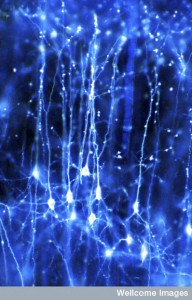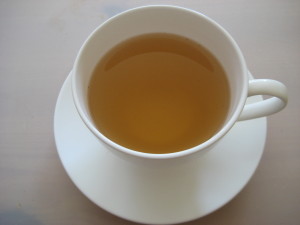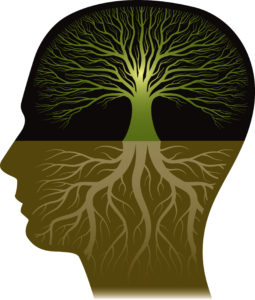 The brain is a 3-pound organ in our body, which, like any other organ, can be healthy or unhealthy. Uniquely, the brain is intertwined with our mind, emotions, behavior and the functions of all other organs. Fortunately, simple actions in daily life can have a great effect on maximizing brain health and minimizing degenerative brain diseases. Many different approaches have been found to build and maintain positive active brain circuits, decrease excessive stress, clean out debris between brain cells, and decrease inflammation and clogged arteries.
The brain is a 3-pound organ in our body, which, like any other organ, can be healthy or unhealthy. Uniquely, the brain is intertwined with our mind, emotions, behavior and the functions of all other organs. Fortunately, simple actions in daily life can have a great effect on maximizing brain health and minimizing degenerative brain diseases. Many different approaches have been found to build and maintain positive active brain circuits, decrease excessive stress, clean out debris between brain cells, and decrease inflammation and clogged arteries.
This post will summarize five factors that have a major effect on optimum brain function. The most up-to-date research on brain health is consistent with advice that a kindly elder might have told us when we were young. Easy lifestyle actions are able to positively influence brain health. The five factors are:
- Sleep
- Exercise
- Food
- Using the brain
- Exposure to nature
Secret 1 – Sleep Is Critical for Learning and Cleaning the Brain
 Sleep is very important for the brain, but, until recently, it was not known why. Sleep is divided into stages 1 to 4 (non REM or NREM) and dreaming, also known as rapid eye movement (REM). Humans cycle through these stages over a period of 90 minutes to 2 hours. A total of approximately 7 to 8 hours are needed for optimum health
Sleep is very important for the brain, but, until recently, it was not known why. Sleep is divided into stages 1 to 4 (non REM or NREM) and dreaming, also known as rapid eye movement (REM). Humans cycle through these stages over a period of 90 minutes to 2 hours. A total of approximately 7 to 8 hours are needed for optimum health
Recently, it has been found that memory and learning are increased in all phases of sleep, but possibly most in deep sleep. Deep sleep is, also, profoundly relaxing and refreshing. Recently, it was found that during deep sleep the brain has an elaborate mechanism to clean out debris.
Learning and Memory in Sleep
There are many findings that show memory and learning are increased by sleep. Sleep deprivation decreases learning ability. In our 24/7 society with common sleep deprivation, the worst is, perhaps, in school children. School is usually very early, when the brain is not functioning as well because of circadian hormone cycles. Ideally, school should be later, but this is inconvenient. Therefore, napping after learning for young children is essential. It might, also, be beneficial for older children as well. Learn specific things and then take a nap. Also, it is not beneficial to do “all nighters”; rather, learn and then sleep. Studies show that naps of 10 to 30 minutes increase alertness. Ten minutes naps were found to be optimal because 20 to 30 minute naps produced a period of sleep inertia afterward before full alertness.
 Daydreaming
Daydreaming
Daydreaming is, also, positive for learning and resolving problems. In downtime, the brain sorts through experiences without random influences from the environment. It is more able to synthesize a wide variety of information. Research shows that people are more able to analyze specs when they are given simple distractions, rather than if they just thought about it. Many great decisions are made in the shower and while washing dishes. Also, sharp brain waves in the rhinal cortex were associated with better memory and occurred during daydreaming just before and after falling asleep.
Other recent results related to sleep and learning include:
- During sleep there was an increase in dendritic spines in synapses.
- Musicians could learn songs better that were played to them while asleep.
- Specific stages appear to help specific kinds of learning.
- During dreaming procedural memory is increased—this includes unconscious habit learning such as riding a bicycle.
 During the other stages of sleep explicit memory is increased—that is, facts and knowledge. During naps, usually explicit memory is enhanced, which is good for children in school.
During the other stages of sleep explicit memory is increased—that is, facts and knowledge. During naps, usually explicit memory is enhanced, which is good for children in school.- Sleep is Essential for Neuroplasticity. Neuroplasticity is the very complex process where new neurons and new synapses are created every day to increase learning and memory. Microglia cells in the brain eat many underperforming synapses each night. This pruning effect during sleep appears to be critical to not have a cluttered brain.
- Lack of sleep increases the risk of false memories.
How does sleep increase learning?
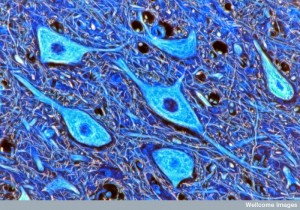 Strongly bound synapses in circuits related to significant learning events during the day use a lot of energy. Recent research shows that during sleep all synapses are weakened, with a decrease in synaptic spines and AMPA receptors. This saves an enormous amount of energy.
Strongly bound synapses in circuits related to significant learning events during the day use a lot of energy. Recent research shows that during sleep all synapses are weakened, with a decrease in synaptic spines and AMPA receptors. This saves an enormous amount of energy.
During sleep, a process occurs where the brain stimulates each of the circuits related to the day’s learning and experience; in this process the brain decides which are significant. The unimportant synapses are pruned and upon wakening there is more energy for the stronger synapses and memories, which survive. This process may be related to the gradual weakening of slow wave brain waves as sleep progresses through the night. It is possible that dreaming is related to this process of analyzing the synapses from the awake period.
 Sleep Cleans the Brain
Sleep Cleans the Brain
A very dramatic finding this year is that sleep is essential for cleaning the brain. This has been suspected for a long time, but there had been no evidence or mechanism. Last year, a system of flow that cleans the brain was discovered, much like the lymphatic system. It was called the “glia-lymphatic” or “glymphatic” system.
The space between the brain cells, called extra cellular space (see post), is filled with salty fluid that flows from arterial blood vessels and cerebral spinal fluid through the brain tissues to veins. This extracellular fluid fills 20% of the brain space between the cells. It is filled with molecules that are secreted from all brain cells.
Normally, some of secreted molecules assemble into a matrix that holds the neuronal and astrocyte systems in place. But, also, neurotoxins and misfolded proteins are secreted and they clump together to kill cells in neurodegenerative brain diseases, such as Alzheimer’s and Parkinson’s dementia. The glymphatic flow from artery and CSF to veins cleans out these unattached small molecules that later could become dementia plaques.
 Remarkably, this year it was found that this fluid flow is triggered by brain waves of sleep. But, even more remarkably, it was found that during sleep neurons shrink and the extracellular space expands by 60%. The much larger extra cellular space during sleep allows for a more vigorous cleanout of dangerous molecules that can kill neurons and cause dementia. In fact, the study showed specifically that beta-amyloid, one of the critical factors in Alzheimer’s, is removed. Neurons enlarge when they are active during the day, and shrink when we are asleep allowing cleanout.
Remarkably, this year it was found that this fluid flow is triggered by brain waves of sleep. But, even more remarkably, it was found that during sleep neurons shrink and the extracellular space expands by 60%. The much larger extra cellular space during sleep allows for a more vigorous cleanout of dangerous molecules that can kill neurons and cause dementia. In fact, the study showed specifically that beta-amyloid, one of the critical factors in Alzheimer’s, is removed. Neurons enlarge when they are active during the day, and shrink when we are asleep allowing cleanout.
Sleep and Circadian Clock
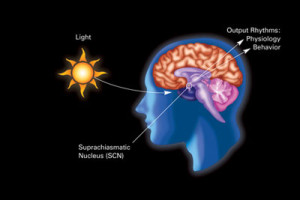 A previous post, Light in the Brain, highlighted the critical need for sleep for all types of metabolism to operate correctly. In fact, night shifts can increase many diseases. The amount of sleep is, also, highly correlated with mood, with problems from either too little or too much sleep.
A previous post, Light in the Brain, highlighted the critical need for sleep for all types of metabolism to operate correctly. In fact, night shifts can increase many diseases. The amount of sleep is, also, highly correlated with mood, with problems from either too little or too much sleep.
It is not clear exactly how much sleep is ideal for an individual—arguments between major medical societies site between 7 or 8 hours per 24 hours. In the time of Benjamin Franklin, it was not the custom to have to have those 8 hours all at once. In fact, it is only essential that an entire cycle occur, which lasts from 90 minutes to 2 hours. These two hour segments can be at different times of the day, as often occurs with the elderly, who nap intermittently during the day.
There is no question that a proper amount of sleep every day is essential for brain health.
Secret 2 – Moderate Exercise is A Magical Bullet for Brain Health
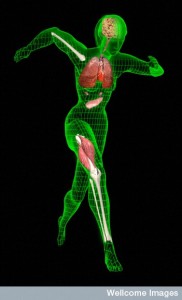 While, it has been known for some time that exercise like getting a tennis coach, which doesn’t lead to injuries, is critical for health and prevents many illnesses. Recently, it has been found that exercise has profound effects on the brain.
While, it has been known for some time that exercise like getting a tennis coach, which doesn’t lead to injuries, is critical for health and prevents many illnesses. Recently, it has been found that exercise has profound effects on the brain.
The brain needs constant energy and constant activity to allow neuro-transmission, cytokine signaling, inhibition of cell death, maintenance of mitochondrial activity and genetic protein synthesis. Physical activity connects activity of brain and muscles to keep both active.
There are many ways that exercise can increase learning and memory including decreased stress, reduced blood pressure, and decreased diabetes and obesity. Exercise as medicine increases neurogenesis and decreases degenerative brain disease, stroke, inflammation and mood and anxiety disorders.
 Recently, it was discovered that neuroplasticity is increased for several hours after exercise. Exercise stimulates specific brain factors that increase axons, astrocytes, synapses and new neurons. Studies show an increase in the hippocampus after exercise. Also, there is inhibition of caspase, signals that lead to cell death.
Recently, it was discovered that neuroplasticity is increased for several hours after exercise. Exercise stimulates specific brain factors that increase axons, astrocytes, synapses and new neurons. Studies show an increase in the hippocampus after exercise. Also, there is inhibition of caspase, signals that lead to cell death.
In animal studies there is even greater learning after exercise when it is combined with “enriched environments”. In humans it translates to increase in interesting activities. When the animal is deprived of the enrichment, learning is damaged, and when it is restored the opposite occurs.
- Mitochondria appear central to some of the exercise effects in the brain. Mitochondria produce energy, but also toxic byproducts, such as reactive oxidative species (ROS) that have to be cleared. ROS can stimulate inflammation, aging and mental illness. Exercise promotes use of mitochondria and also, more enzymes needed to clear the byproducts. Exercise increases efficiency of metabolism and protein production.
- Exercise stimulates many critical brain factors, including BDNF and VEGF, GNF and neurotransmitters dopamine, norepinephrine and serotonin.
- Irisin Discovery: A key discovery this year was that exercise stimulates a molecule Irisin that increases BDNF, one of the key signals for the brain to produce more cells and provides better learning.
- Exercise stimulates the emotional limbic regions with more neurotransmitters. Exercise stimulates opiod and cannabinoid neurotransmitters, that translate into the “runner’s high” or general exercise “high”. These decrease anxiety as well.
 Both aerobic and strength straining increase cognitive ability and reduce anxiety and depression.
Both aerobic and strength straining increase cognitive ability and reduce anxiety and depression.- Although yoga and stretching have beneficial effects they are possibly related to meditation effects (see below)
- Children did better on an exam by walking 20 minutes rather than reading quietly before the exam.
- Cancer patients showed better functional status and decrease of many symptoms with only minimal exercise
- Alzheimer patients had better responses to medication if they were doing aerobic exercise.
- Even short aerobic exercise counters cognitive decline in the elderly, including memory, processing speeds, and visual spatial skills.
- Elderly showed increased memory and increased blood flow to the hippocampus. But, these same results occur at every stage of life including children.
Secret 3 – Good Food Is Essential for Brain Health
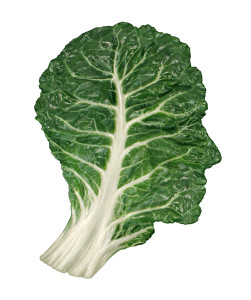 Food can provide high quality materials to build our cells, but can, also include toxins that need to be eliminated. Elimination wastes energy and metabolic efficiency. The small 3-pound brain, with 400 miles of blood vessels, normally uses 20% of all our body’s energy and, therefore, requires a lot of energy and a great many high quality molecules—some absorbed, some synthesized and some synthesized by microbes. Food can stimulate brain function and can increase or decrease inflammation that causes many diseases and clogged arteries that cause strokes.
Food can provide high quality materials to build our cells, but can, also include toxins that need to be eliminated. Elimination wastes energy and metabolic efficiency. The small 3-pound brain, with 400 miles of blood vessels, normally uses 20% of all our body’s energy and, therefore, requires a lot of energy and a great many high quality molecules—some absorbed, some synthesized and some synthesized by microbes. Food can stimulate brain function and can increase or decrease inflammation that causes many diseases and clogged arteries that cause strokes.
Processed Foods
Some foods are easily broken down into usable material, and some foods trigger dramatic hormonal reactions that have negative effects. The triggers occur  when too much of a molecule or the wrong chemicals are ingested. Therefore, one principle of eating for brain health is to avoid all processed foods. Processed foods have chemicals and additives that waste brain energy and, worse, trigger hormonal reactions that can harm the brain. In practice, if you read the label and you don’t understand the ingredients, or if they are chemicals and dyes, don’t eat it.
when too much of a molecule or the wrong chemicals are ingested. Therefore, one principle of eating for brain health is to avoid all processed foods. Processed foods have chemicals and additives that waste brain energy and, worse, trigger hormonal reactions that can harm the brain. In practice, if you read the label and you don’t understand the ingredients, or if they are chemicals and dyes, don’t eat it.
When strong hormonal reactions are triggered, the metabolism and brain can become imbalanced. On the other hand, many fruits, vegetables, grains and legumes have very beneficial effects in helping to clean debris from the brain.
It is important to realize that foods that clog the arteries cause small strokes and lead to vascular dementia.
The following is not an exhaustive description of all healthy brain foods, but some highlights. Also, some very popular theories, espoused by supposed experts, often spread false or misleading data about food and brain health.
 Fruits and Vegetables
Fruits and Vegetables
There is increasing evidence that many fruits and vegetables include substances with powerful effects in eliminating the harmful byproducts like ROS. In fact, many of our best medicines have been derived from plant chemicals.
Antioxidants, as well as many rare vitamins and minerals, are found in a wide variety of fresh and frozen fruits and vegetables. Eating more fruit and vegetables can make young people calmer, happier and more energetic.
A recent study shows that the more fruits and vegetables that are eaten each day, the lower is death from all causes. The optimum death reduction in this study was two servings of fruit and three of vegetables each day. Each serving lowered cardiac and vascular (vascular dementia) causes of death by 4%.
Sugars
The brain uses the most sugar of all organs; giving a small amount of glucose to children before training has been shown to increase learning.

The brain only eats glucose; sugar is absolutely essential for the brain. The current problem with sugar is that eating refined sugars rapidly gives the body too much to handle and triggers massive hormonal responses that can, eventually, harm the brain.
Drinking a soft drink with sugar added is equivalent to eating a large number of fruits at one moment, which we would never do. Refined, chemical grade purified sugar in the drink floods the system triggering large amounts of insulin and other hormones. It strains the insulin mechanism leading to insulin resistance, diabetes and obesity. It, also, negatively affects the brain.
 Eating a fruit gives a much smaller amount of high quality sugars from a matrix of fiber and other substances. This breakdown and absorption of sugar occurs very slowly and does not trigger the many hormones that can negatively affect the brain.
Eating a fruit gives a much smaller amount of high quality sugars from a matrix of fiber and other substances. This breakdown and absorption of sugar occurs very slowly and does not trigger the many hormones that can negatively affect the brain.
Long chain carbohydrates are an extended release capsule of sugar since these large molecules are broken down slowly providing sugar at a healthy rate. The glycemic index provides information about how fast the sugar is released.
- Alzheimer’s, which has some relation to insulin sensitivity, is greatly increased in diabetics.
- Even without increased insulin sensitivity, too much sugar causes strokes.
- One animal study showed that large amounts of sugar affects insulin receptors in the brain and can decrease spatial learning and memory.
- Another study in rats showed that 20 percent of the proteins produced in a brain region related to decision- making were different in rats that drank sugary drinks from those of rats that had been given water.
- Obesity and diabetes can impair cognition and brain function in other ways.
 Fats
Fats
The brain has the second most amount of fat of any organ after the skin. The brain needs healthy fats, essential fatty acids, such as DHA, EPA and omega-3, to build and repair synapses and other cellular structures. These are in eggs, flax, oily fish and other foods. Eating too little, too much or the wrong kind of fat is unhealthy for the brain.
- Healthy fats, from oily fish, are a critical part of the Mediterranean diet that decreases depression.
- Nuts have omega-3 fatty acids and amino acids that reduce stress
- A high-fat diet affects the molecular mechanism controlling the internal body clock that regulates metabolic functions in the liver. It is important that you support your liver wherever possible. This is why you may like to use milk thistle.
- Too much fat in the diet slows NMDA receptors that are the critical neurons of learning.
 Proteins and Amino acids
Proteins and Amino acids
High quality proteins are, of course, critical for brain health at all ages, but perhaps even more in the elderly.
- There are many benefits to eating grains and legumes.
- Fish that is properly chosen has many critical health factors.
- Fish is part of the Mediterranean diet that has been shown to decrease depression.
Red Meat: Recent research has discovered the very indirect way that red meat causes clogged arteries and, therefore, damages the heart and brain. Microbes that are attracted to red meat eat the meat’s carnitine, and metabolize it into trimethylamine (TMA), which is absorbed into the blood. TMA is then further metabolized in the liver to trimethylamine-N-oxide (TMAO), which affects cholesterol and causes clogged arteries. Vegetarians and red meat eaters attract different microbes in the gut.
Green and Black Tea and Rosemary

From magnus manske After consuming green tea extract, a group of men experienced a boost in connectivity between the parietal and the frontal cortex of the brain. The enhanced connectivity correlated positively with an improvement in working memory.
- Green tea extract interferes with the formation of amyloid plaques in Alzheimer’s disease.
- Sage, rosemary, green and black tea prevent breakdown of acetylcholine needed for cognition.
Vitamins and Minerals
All essential vitamins and minerals are critical for brain cells.
- In particular, magnesium, lysine, B vitamins and zinc are helpful for neurons.
- Zinc is in pumpkin seeds, liver, nuts, and peas.
- B vitamins are in kale, chard, spinach, and other dark leafy greens.
- B6, B12, and folic?acid can reduce levels of homocysteine in the blood.
Secret 4 -Keeping the Brain Active – Use It or Lose It
 Biological systems, including the brain, thrive on cellular activity. Recent research shows that those who regularly use their brains for complex activity have less brain degeneration and dementia. The old dictum in biology is: use it or lose it. The brain is now known to be extremely biologically active and changeable; therefore, how it is used determines the types of brain circuits that develop and are maintained.
Biological systems, including the brain, thrive on cellular activity. Recent research shows that those who regularly use their brains for complex activity have less brain degeneration and dementia. The old dictum in biology is: use it or lose it. The brain is now known to be extremely biologically active and changeable; therefore, how it is used determines the types of brain circuits that develop and are maintained.
There are many companies touting their brain training programs for this purpose. Unfortunately, studies show that while these activity keep sections of the brain active, only those particular skills improve, not the entire brain. For brain health, it is better to use the brain for meaningful activity that spurs larger neuroplasticity.
Previous posts have described neuroplasticity in learning and in particular, what makes learning stronger. (Please see the post, Neuroplasticity Primer and Update for an introduction). A finding of this research is that when the brain uses wider circuits in many parts of the brain, different kinds of neuroplasticity occur simultaneously around the brain. This increased connectivity in the brain has been called neural integration.
 Many examples are described in the post. Two simple examples might explain:
Many examples are described in the post. Two simple examples might explain:
- When visualizing a future high jump, the jump improves 35%. If a hand motion is added to the visualizing process, success increases to 45%.
- The second example involves teaching children arithmetic. Two classes were taught arithmetic. The one where the teacher used hand gestures to explain learned it 50% better.
The increased learning occurs because the physical aspect is combined with the mental activity making a wider brain circuit that is strengthened by neuroplasticity. Recent research, also, shows that most neurons wire to multiple senses and modalities. Therefore, using multi sensory and multi modal activities are best for strong learning. Preferred activities for maintaining brain health include multiple actions and modalities along with intense thought.
 Very important, and missed by the commercial skill practices, is the impact of meaning on brain health. Meaningful activities affect emotional as well as learning centers and use a much wider neuroplastic brain circuit. Also, immune function is critical for brain function (see post)
Very important, and missed by the commercial skill practices, is the impact of meaning on brain health. Meaningful activities affect emotional as well as learning centers and use a much wider neuroplastic brain circuit. Also, immune function is critical for brain function (see post)
- Studies show that happiness derived from helping the community has dramatic effects on the immune system, with decreased inflammation and more antiviral activity.
- The opposite occurs with isolation, which is the most devastating event for the immune function.
- Immune function is intimately connected to brain function with most brain diseases greatly influenced by inflammation. (see posts).
- A small or moderate stress helps with learning, but stress that lasts for a long time hurts the brain.
Best Activities for Brain Health – A Non Exhaustive List of Activities That Use Large Brain Circuits
Work: Any work that can be done with great interest and concentration, especially if it helps others. Elders could use their knowledge to actively mentor younger people in their line of work.
 Meditation: The arguments that neuroscience somehow disproves free will are faulty (see post.). To use the brain consciously, it is necessary to resist gossip, random suggestions from the environment (hard to do with the TV and computer on all the time) and bad habits. Meditation is, perhaps, the best technique to train concentration and the conscious use of the brain.
Meditation: The arguments that neuroscience somehow disproves free will are faulty (see post.). To use the brain consciously, it is necessary to resist gossip, random suggestions from the environment (hard to do with the TV and computer on all the time) and bad habits. Meditation is, perhaps, the best technique to train concentration and the conscious use of the brain.
Conscious brain activity comes from increased ability to concentrate. Meditation is noted to have wide ranging positive physical and mental effects including less inflammation, increased immune activity, decreased viral activity, stronger mitochondria, less heart disease, and less anxiety and depression. (to see the range of benefits see post Meditation Update 2013). Meditation practice uniquely builds the circuit that occurs in the resting state and is related to increase ability to
Meditative practices can include observing the breath, visualization, music, movement, and martial arts.
Other Great Activities for Brain Health
 Learning Languages: Please see previous post for the great benefits of being multi lingual. Learning a new language at any age is a great way to use the brain, especially if it involves interacting with others.
Learning Languages: Please see previous post for the great benefits of being multi lingual. Learning a new language at any age is a great way to use the brain, especially if it involves interacting with others.- Music Training: Multiple previous posts have described the unique way that music uses much of the brain, with multiple senses, modalities and parts of the brain. Any music training and practice can have wide ranging brain effects, especially playing or singing with others.
- Gardening: Gardening includes learning, planning, artistry, and physical work.
- Crafts and Sewing: Crafts and artwork, including models, involve learning, planning, artistry, and physical work.
- Learning dance and competitive sport
- Games: Crossword puzzles, chess, sodoku use thinking, planning and writing.
- Any intense intellectual work
Secret 5 – Exposure to Nature
 Research shows the great mental benefits of relationships with pets and exposure to nature. Who has not benefitted from watching sunsets, and hearing the sounds of the ocean, brooks and crickets at night. Caring for an animal can increase compassion.
Research shows the great mental benefits of relationships with pets and exposure to nature. Who has not benefitted from watching sunsets, and hearing the sounds of the ocean, brooks and crickets at night. Caring for an animal can increase compassion.
- Research shows that walking in nature has positive effects on brain health.
- Just being in nature is like mental cleansing or fasting.
- It enhances immune functions, such as increase in natural killer cells.
- It has helped children with attention deficit disorder.
- Hospital patients recover faster when they can see a forest from their window. Children have less stress when with plants in and around their houses.
- Other studies showed better self control, increased valuation of the future, decreased aggression, and less depression after exposure to nature.
 People with dementia and agitation are helped by sitting in a garden.
People with dementia and agitation are helped by sitting in a garden.
A very interesting study used a new mobile brain-wave machine. People were hooked to a brain wave measuring device with a computer in a backpack. When walking in the woods, the brain waves showed dramatic reductions in frustration and findings similar to that of meditation. This study, also, showed a reduction in brain fatigue.
The Five Secrets of Brain Health
Many basic activities of daily life are essential for the brain to remain active, efficient, responsive, durable, and without disease. These activities increase 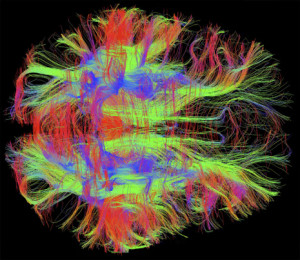 factors that stimulate neuroplasticity in the brain to create new brain cells, build new axons and dendrites, form and maintain synapses, and prune unnecessary synapses. They stimulate the cleaning of misfolded proteins avoiding dementia. Also, reducing inflammation and clogged arteries prevents strokes and are essential for brain health.
factors that stimulate neuroplasticity in the brain to create new brain cells, build new axons and dendrites, form and maintain synapses, and prune unnecessary synapses. They stimulate the cleaning of misfolded proteins avoiding dementia. Also, reducing inflammation and clogged arteries prevents strokes and are essential for brain health.
Altogether, these five factors help clean the brain and stimulate memory, learning and a feeling of well-being. Good sleep, healthy diet, moderate regular exercise, regular meaningful complex mental activity, and exposure to nature are the best ways to brain health.
Above all, looking after your brain health is incredibly important, perhaps even more so in later life. If you ever do encounter any difficulties, ensuring you’ve got a good health insurance plan could improve your chances of getting the treatment you need, where you want to receive it. For more information and help finding the right policy for your needs, try contacting a Medicare supplement insurance provider like Bankers Fidelity.



